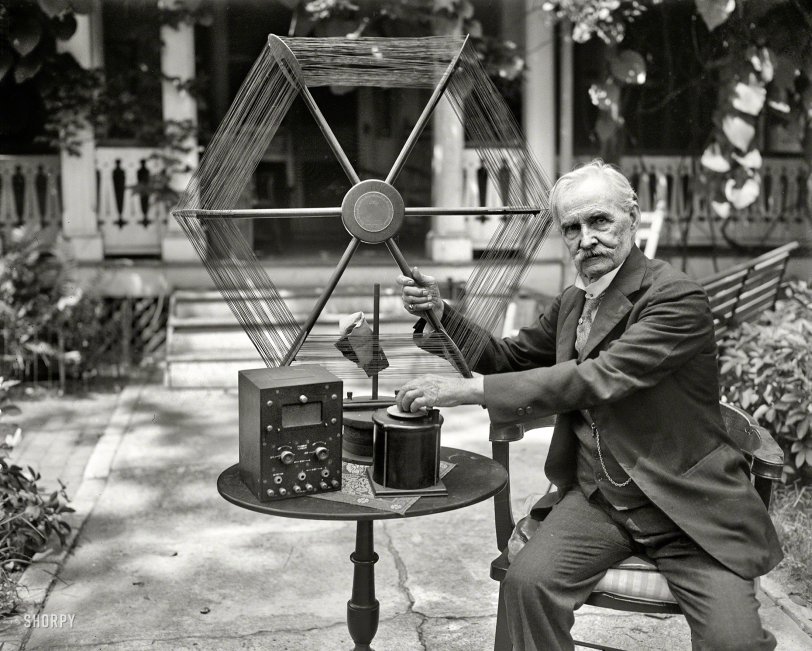


Framed or unframed, desk size to sofa size, printed by us in Arizona and Alabama since 2007. Explore now.
Shorpy is funded by you. Patreon contributors get an ad-free experience.
Learn more.

- Baldwin 62303
- Baldwin VO-1000
- Cold
- No expense spared
- Tough Guys
- Lost in Toyland
- And without gloves
- If I were a blindfolded time traveler
- Smoke Consumer Also Cooks
- Oh that stove!
- Possibly still there?
- What?!?
- $100 Reward
- Freeze Frame
- Texas Flyer wanted
- Just a Year Too Soon
- WWII -- Replacing men with women at the railroad crossing.
- Yes, Icing
- You kids drive me nuts!
- NOT An Easy Job
- I wonder
- Just add window boxes
- Icing Platform?
- Indiana Harbor Belt abides
- Freezing haze
- Corrections (for those who care)
- C&NW at Nelson
- Fallen Flags
- A dangerous job made worse
- Water Stop
Print Emporium
Radio Alfresco: 1929

UPDATE: Our subject is Dr. James Harris Rogers (1856-1929) of Hyattsville, Md., inventor of the "loop aerial" and holder of numerous patents in telegraphy, telephony and radio:
August 16, 1929. A Veteran Inventor. About 6 miles from Washington, on the edge of the little hamlet of Hyattsville, Md., may be found Dr. James Harris Rogers, wizard inventor, now 80 years old, retired from his work but still erect and energetic. It was Dr. Rogers who during the war proved that water as well as earth and air is a medium for the transmission of electro-magnetic waves. Through the "well" located on his property, high officials heard German official reports.
Radio apparatus and unidentified operator circa 1930 in this unlabeled Harris & Ewing plate. Who can help us fill in the blanks? View full size.
The Rogers Cage Antenna
This appears to be an antenna that Dr. Rogers used in his experiments involving radio communications transmitted through the earth rather than through the air. In this document there is a drawing of an apparatus using an antenna strongly resembling the one he is holding in our picture. In his experiments, Dr. Rogers was able to hear European long wave stations with the antenna confined to the well, but when the antenna was brought into the air, the stations could not be heard at all.

Hyattsville Site
The Hyattsville, Maryland, home of Dr. Rogers was called Firwood, I believe, and his laboratory was next to his home. Both were demolished years ago and the property is now the site of the Prince Georges County Justice Center on Route One.
Jim (Hyattsville resident)
Cage Antenna
So says the label on the loop. This is a type of antenna in use even today, with the conducting elements arranged in a tubular fashion around a series of insulating spacers or discs. They are usually linear; I've never before seen one arranged as a loop.
Dr. Rogers was apparently a very prolific inventor who worked on a system to communicate by radio with submerged submarines. In the photo, he seems very proud of his work.
RADIO BULLETIN
Our subject is Dr. James Harris Rogers (1856-1929) of Hyattsville, Maryland, inventor of the "loop aerial" and holder of numerous patents relating to telegraphy, telephony and radio.
Dagnabit!
"I been messin' with this radeeo box since 19 ought 19 and she ain't brought in a station yet!"
Photographer's errors abound.
Typical photographer's mockup - I'm an audio professional, and advertisers and films constantly show microphones or guitars supposedly in use that are not plugged in, people speaking into the wrong end, and dubbing in feedback when not needed. I think many photographers are really quite stupid in cases of representing real life!
[You're completely missing the point of the photo. - Dave]
I don't think we are in Kansas anymore
I'm guessing the operator is Frank Morgan, sure looks like
the Great Oz.
More like 1920?
Radio was pretty advanced by 1930 in areas of technology, programing and in the receivers themselves. Period advertising shows them having beautiful wooden cabinetry with integral speakers by then (if anyone had any money with which to actually buy them after the stock market crash.)
[The photo is from around 1930. I think the idea here was to show someone of historical importance in the development of broadcasting. - Dave]
Related?
Is Al Fresco related to that renowned radio pioneer, Guglielmo Marconi?
Not the sharpest image
Nice image, but it looks like someone got carried away with manipulations.
[Operator error. Hit refresh! - Dave]
Dead Air
Not much chance of reception since there is nothing plugged into the jacks on the receiver. The paper stuck in the wires is obviously the instructions! Time for the old radio experts to identify the parts.
[Also missing: speaker or headset. - Dave]
Looks like old stuff even then
Looking in detail, nothing is connected to anything else (the box could be, but all the terminals are in front and nothing is visible there). It is using a loop antenna - which is somewhat directional and for a relatively long wavelength. The receiver looks like a regenerative receiver or an early super heterodyne. (my bet is the regenerative). The loop antenna itself isn't necessarily directly connected to a receiver, but the tuning capacitor (?) should be.
It looks like an anonymous radio pioneer showing off his old gear.
Should I Choose Better Service or a Better Phone?
I get Shorpy via the RSS feed, and the above title was just under this photo. The further irony being that my Google Reader will soon be like the radio in the picture: gone.
























On Shorpy:
Today’s Top 5